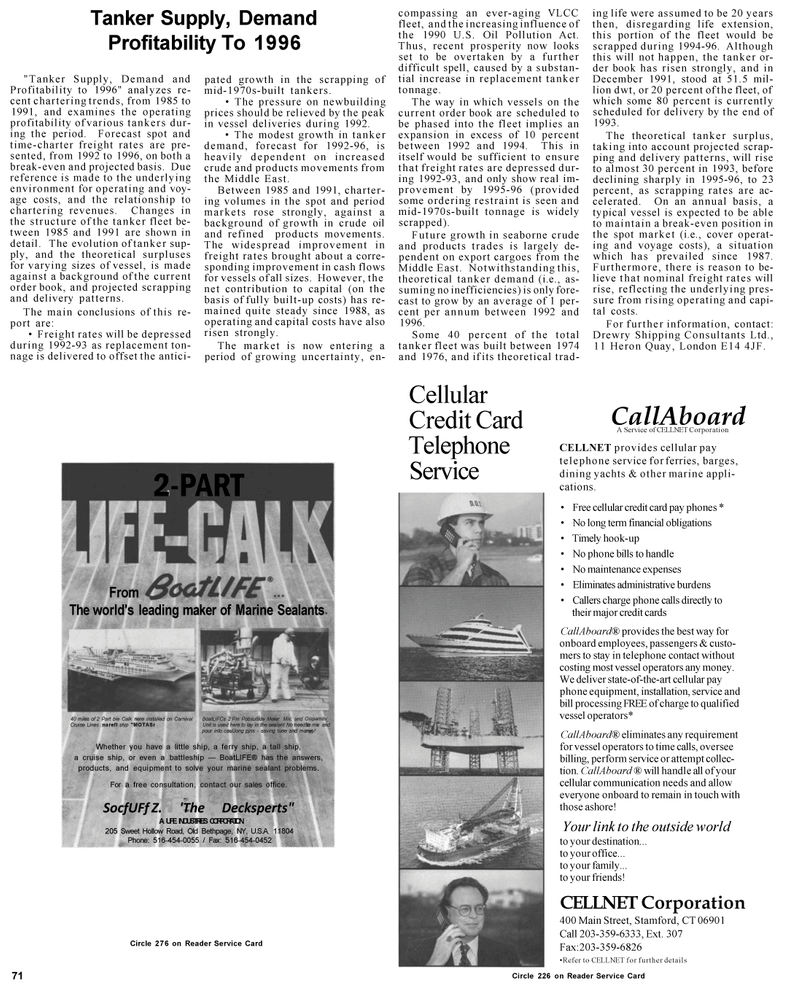
Page 8: of Maritime Reporter Magazine (March 1992)
Read this page in Pdf, Flash or Html5 edition of March 1992 Maritime Reporter Magazine
Tanker Supply, Demand
Profitability To 1996 "Tanker Supply, Demand and
Profitability to 1996" analyzes re- cent chartering trends, from 1985 to 1991, and examines the operating profitability of various tankers dur- ing the period. Forecast spot and time-charter freight rates are pre- sented, from 1992 to 1996, on both a break-even and projected basis. Due reference is made to the underlying environment for operating and voy- age costs, and the relationship to chartering revenues. Changes in the structure of the tanker fleet be- tween 1985 and 1991 are shown in detail. The evolution of tanker sup- ply, and the theoretical surpluses for varying sizes of vessel, is made against a background of the current order book, and projected scrapping and delivery patterns.
The main conclusions of this re- port are: • Freight rates will be depressed during 1992-93 as replacement ton- nage is delivered to offset the antici- pated growth in the scrapping of mid-1970s-built tankers. • The pressure on newbuilding prices should be relieved by the peak in vessel deliveries during 1992. • The modest growth in tanker demand, forecast for 1992-96, is heavily dependent on increased crude and products movements from the Middle East.
Between 1985 and 1991, charter- ing volumes in the spot and period markets rose strongly, against a background of growth in crude oil and refined products movements.
The widespread improvement in freight rates brought about a corre- sponding improvement in cash flows for vessels of all sizes. However, the net contribution to capital (on the basis of fully built-up costs) has re- mained quite steady since 1988, as operating and capital costs have also risen strongly.
The market is now entering a period of growing uncertainty, en- compassing an ever-aging VLCC fleet, and the increasing influence of the 1990 U.S. Oil Pollution Act.
Thus, recent prosperity now looks set to be overtaken by a further difficult spell, caused by a substan- tial increase in replacement tanker tonnage.
The way in which vessels on the current order book are scheduled to be phased into the fleet implies an expansion in excess of 10 percent between 1992 and 1994. This in itself would be sufficient to ensure that freight rates are depressed dur- ing 1992-93, and only show real im- provement by 1995-96 (provided some ordering restraint is seen and mid-1970s-built tonnage is widely scrapped).
Future growth in seaborne crude and products trades is largely de- pendent on export cargoes from the
Middle East. Notwithstanding this, theoretical tanker demand (i.e., as- suming no inefficiencies) is only fore- cast to grow by an average of 1 per- cent per annum between 1992 and 1996.
Some 40 percent of the total tanker fleet was built between 1974 and 1976, and if its theoretical trad- ing life were assumed to be 20 years then, disregarding life extension, this portion of the fleet would be scrapped during 1994-96. Although this will not happen, the tanker or- der book has risen strongly, and in
December 1991, stood at 51.5 mil- lion dwt, or 20 percent of the fleet, of which some 80 percent is currently scheduled for delivery by the end of 1993.
The theoretical tanker surplus, taking into account projected scrap- ping and delivery patterns, will rise to almost 30 percent in 1993, before declining sharply in 1995-96, to 23 percent, as scrapping rates are ac- celerated. On an annual basis, a typical vessel is expected to be able to maintain a break-even position in the spot market (i.e., cover operat- ing and voyage costs), a situation which has prevailed since 1987.
Furthermore, there is reason to be- lieve that nominal freight rates will rise, reflecting the underlying pres- sure from rising operating and capi- tal costs.
For further information, contact:
Drewry Shipping Consultants Ltd., 11 Heron Quay, London E14 4JF.
Cellular
Credit Card
Telephone
Service
Circle 276 on Reader Service Card
CallAboard
A Service of CELLNET Corporation
CELLNET provides cellular pay telephone service for ferries, barges, dining yachts & other marine appli- cations. • Free cellular credit card pay phones * • No long term financial obligations • Timely hook-up • No phone bills to handle • No maintenance expenses • Eliminates administrative burdens • Callers charge phone calls directly to their major credit cards
CallAboard® provides the best way for onboard employees, passengers & custo- mers to stay in telephone contact without costing most vessel operators any money.
We deliver state-of-the-art cellular pay phone equipment, installation, service and bill processing FREE of charge to qualified vessel operators*
CallAboard® eliminates any requirement for vessel operators to time calls, oversee billing, perform service or attempt collec- tion. CallAboard ® will handle all of your cellular communication needs and allow everyone onboard to remain in touch with those ashore!
Your link to the outside world to your destination... to your office... to your family... to your friends!
CELLNET Corporation 400 Main Street, Stamford, CT 06901
Call 203-359-6333, Ext. 307
Fax:203-359-6826 •Refer to CELLNET for further details 71 Circle 226 on Reader Service Card
From
The world's leading maker of Marine Sealants 2-PART
Oispemini to mix and my! 40 miles of 2 Part ble Calk nere installed on Carnival BoatLIFCs 2 Pin Pobsultide Meier. Mix. and
Cruise Lines narefl ship "MOTASr Unit is used here to lay in the sealant No need to mx pour into cauUong pjns - saving tune and money!
Whether you have a little ship, a ferry ship, a tall ship, a cruise ship, or even a battleship — BoatLIFE® has the answers, products, and equipment to solve your marine sealant problems.
For a free consultation, contact our sales office.
SocfUFf Z. 'The Decksperts"
A UFE INDUSTRIES CORPORATION 205 Sweet Hollow Road, Old Bethpage, NY, U.S.A. 11804
Phone: 516-454-0055 / Fax: 516-454-0452

 7
7

 9
9
